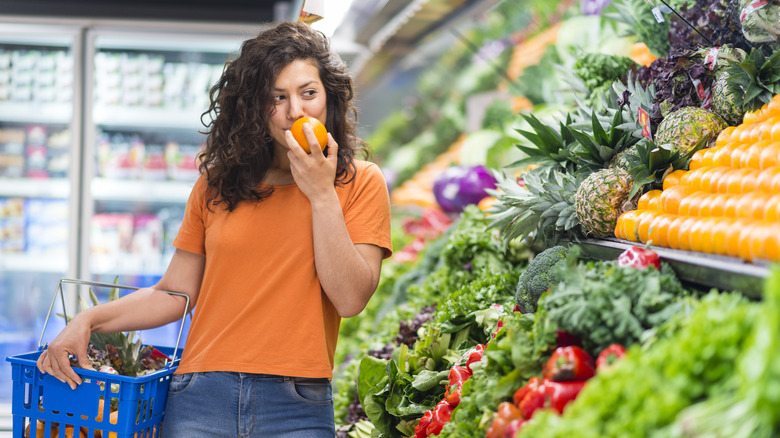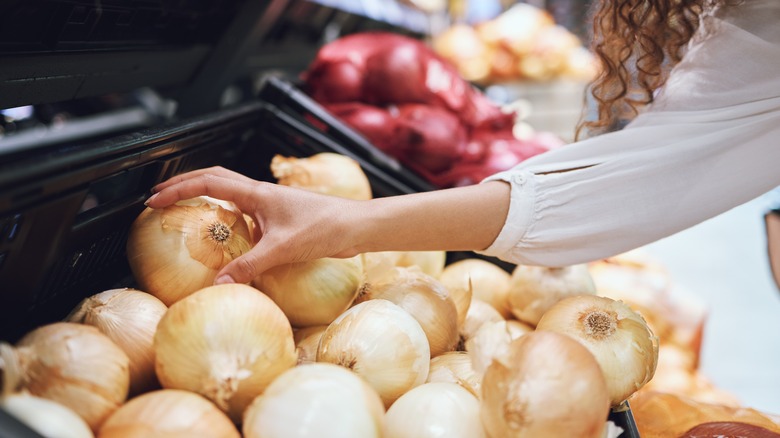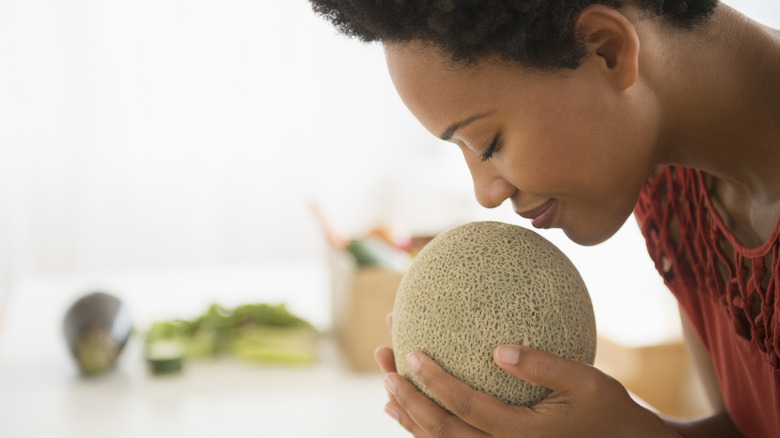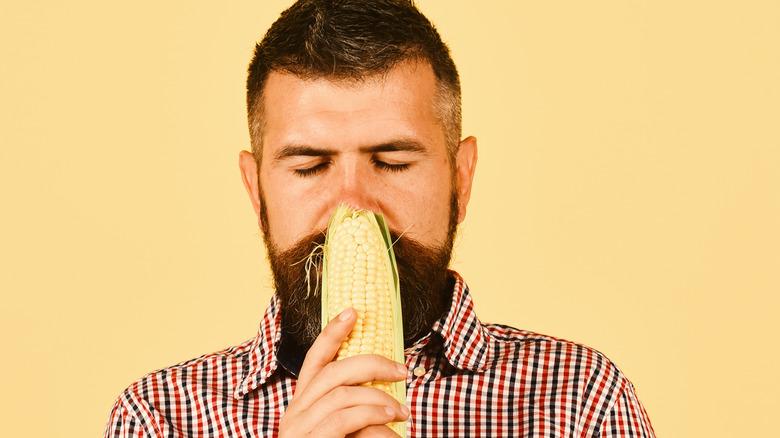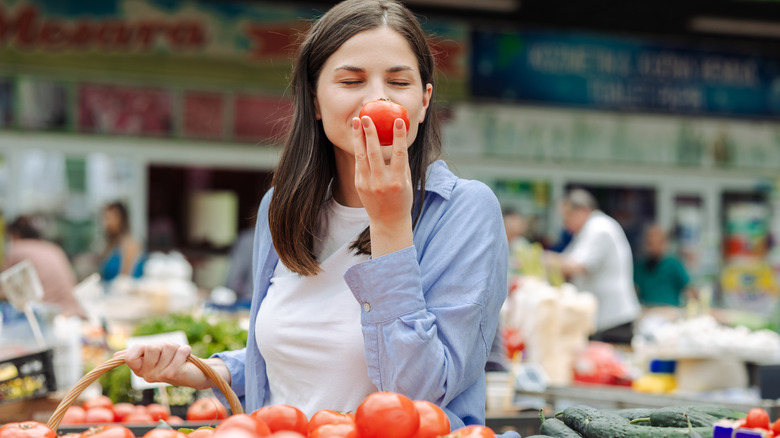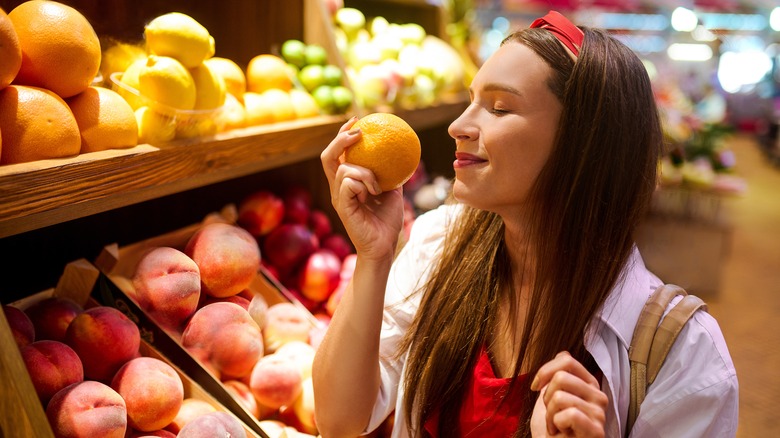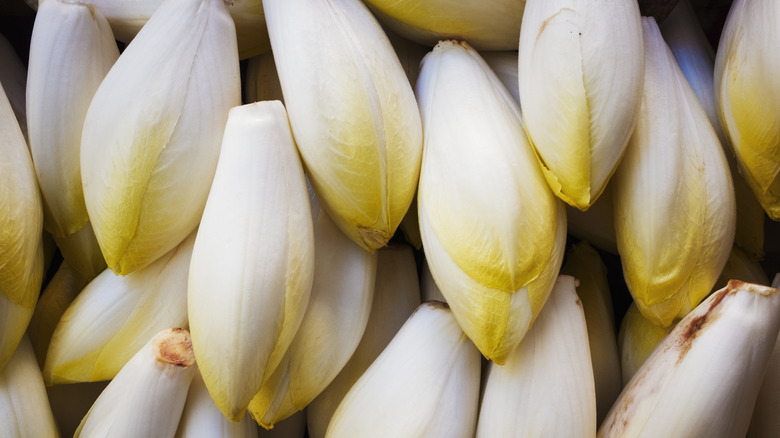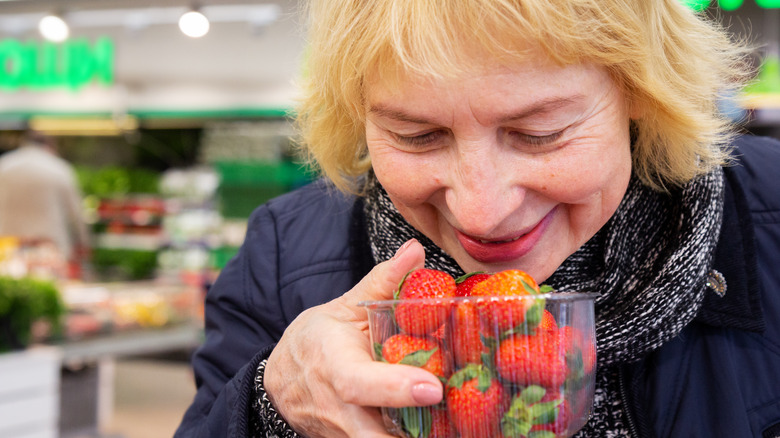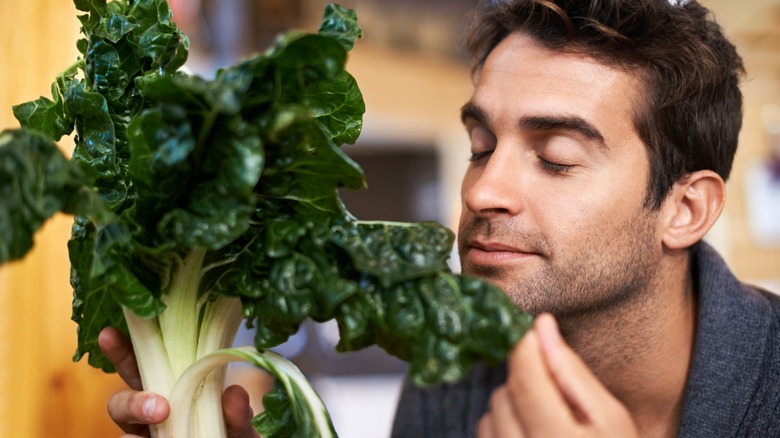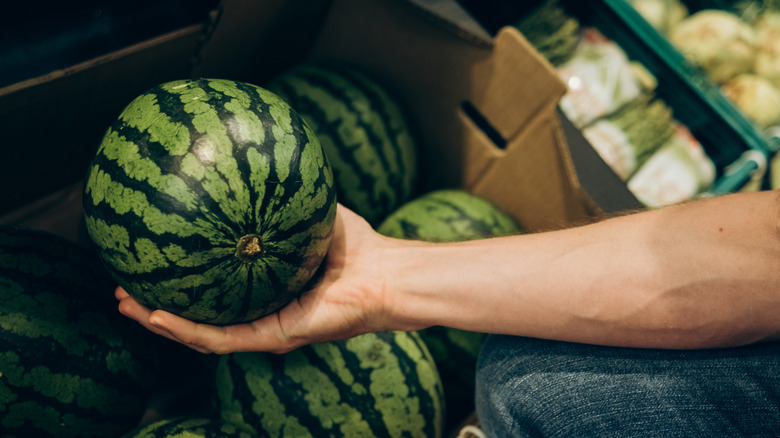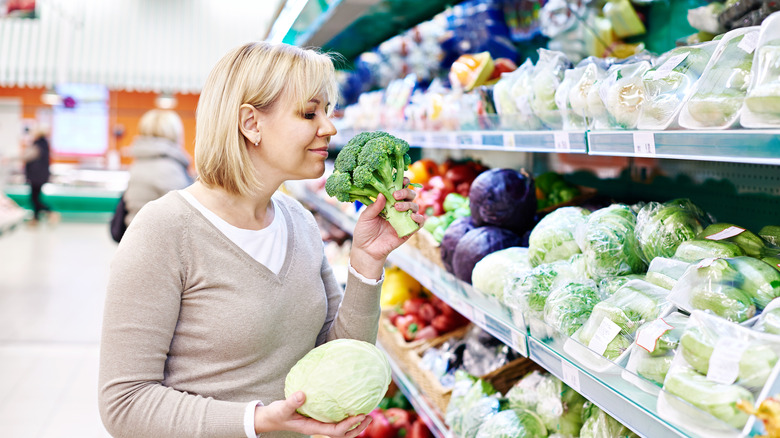14 Fruits And Vegetables You Should Smell Before You Buy
The old adage goes that "we eat with our eyes first." What about our noses, though? The scent of food is one of the most important factors in our enjoyment of it, and crucially in our ability to tell whether it's fresh or not when we're buying it. This is arguably even more important with fruits and vegetables. The aromas of our fresh produce are clear indicators of where they're at in their ripening cycle. With fruit, for example, its scent is produced by volatile compounds in the plant, with substances like lactones and esters respectively giving fruits peachy or fruity aromas. The more compounds there are, the more intense your fruit's flavor is going to be.
As such, getting our noses close to our fresh produce before we buy it is one of the quickest and most reliable ways to tell that we're getting something good. What might surprise you, too, is that way more fruits and vegetables than you think can indicate how fresh they are by their scent. Unlikely produce like corn on the cob, endives, and uncut watermelons can tell us by their smell (or a lack of it) whether they're good to go, or whether they're past their prime and should be left on the shelf.
1. Peaches
Telling whether peaches are ripe or not is trickier than you might think. Just as there's a correct way to store peaches, there's also a correct way to buy them: by getting them close to your nose. Peaches should have a strong, sweet, fresh smell when they're at their ripest, created by the lactones in the fruit. This heightened scent is also something you should look out for in other stone fruits like plums and nectarines as an indicator of freshness.
Unfortunately, smelling their peaches is something that way too many people just don't do. Instead, they rely on how it feels in their hand. While this can work, John Vena's Director of Marketing Emily Kohlhas notes that this shouldn't be at the expense of scent. "If a peach has a light give and feels ripe, but you can't smell a thing, be wary," Kohlhas told America's Test Kitchen. "If it feels ripe and smells good — that's a good sign." If it has a give but not much smell, it might just not be ready yet. However, if the peach you just picked up is soft and accompanied by a vinegary, fermented, or sour smell, you should leave it where it is: It's probably going bad.
2. Onions
It's no secret that onions give off a strong smell. The moment you cut into them, your nose is assaulted by their acrid, bitter scent that mellows out into a moreish, delectable aroma once they're cooked. However, one important thing to remember is that onions can have a smell before you even cut into them — and that's not a good thing.
The reason why it's so crucial to sniff your onions before popping them in your basket is because if they smell like onions, you should leave them on the shelf. Huh? Let us explain. If your onions smell like onions before they've been sliced or peeled, it's a surefire sign that they've been damaged in some way. Once their cell walls are broken, they start to release their pungent aroma. However, this same damage (which occurs when you slice them) also hastens how quickly they go bad. Therefore, if you're buying onions that smell strongly of onion, they'll probably ruin your food. Instead, you should look for firm onions that have barely any smell to them, which indicates that they're still intact. If they're soft or have any visible signs of damage, you should leave them where they are.
3. Cantaloupe
Before you've cut into a cantaloupe, figuring out whether it's fresh or not can be pretty tough. The mosaic-like skin of the fruit doesn't give too much away about its ripeness, and this can lead to a lot of completely wasted purchases. One of the best ways to tell, however, is by giving one of its ends a sniff. Pick up your cantaloupe and turn it to its blossom end (that's the end opposite where it was cut off its stem, where the flower once grew). Get your nose up against it. If it has a gently sweet, fruity smell, then it's a good sign that the cantaloupe is fresh and ready to be eaten.
What you don't want is an absence of smell, or an overly-funky scent. No smell means that your cantaloupe isn't ripe yet, and any funky or vinegary notes will flag that the cantaloupe is about to go bad, or has gone bad already. Another good way to tell whether your cantaloupe is ripe or not is to give the blossom end a light poke. If it yields slightly to your touch or is gently cracked, the fruit is probably good to go.
4. Bell peppers
There are some pretty obvious signs that your bell peppers have gone bad. They can be soft and mushy to the touch, look noticeably browner or wilted, or may have started to shrivel. However, there's one key way to tell that can show up before you notice any of these, and that's by their smell. Whether they're red, yellow, or green, bell peppers release a rancid, acrid scent when they've started to turn bad. This smell will show up whether they've been sliced or not, and it could indicate interior spoilage or rotting that hasn't yet shown up on the outside of the produce.
By contrast, ripe bell peppers will have a vibrant, zesty smell. They have a noticeably grassy scent that's accompanied by a particularly bright hue on the pepper itself, with a slight fruitiness to it. This smell will get stronger when you cut the pepper, but it will still be noticeable when it's whole. This is paired with a firm-feeling fruit, and no brown or black patches on it. If there's any mold on it too, needless to say that it's a pepper you really shouldn't be eating.
5. Pineapple
Figuring out whether a pineapple's ripe or not can be super tricky. If it hasn't been sliced yet, it can often feel like you're essentially left to guess whether the fruit's actually be ready to eat or not. This can lead a lot of people to either buying pineapples that are unripe, resulting in them having to wait days until it's ready to eat, or else way past its prime and completely unusable.
The way to pick the right pineapple? Use your nose. Pick up that pineapple and stick your nose into the bottom end. If the pineapple smells fresh, juicy, and like you imagine a pineapple should smell, then it's likely that'll be just right and ready to eat. It should also have a distinctly sweet smell to it, which will indicate that it'll have a sweet flavor; if it has an acidic edge to its scent, it'll probably be a little unripe and tart. By contrast, if the pineapple you've just picked is way off being ripe, it won't have much of a smell at all, and should be left to mature at its own pace. If it smells nasty, on the other hand? It's gone bad, and you should pick another one instead.
6. Corn on the cob
Figuring out whether corn on the cob is ripe or not should be as easy as looking at it, right? Not quite. If you're in a store where the cobs are wrapped in the husk with the tassel still intact, it's not really a good look to be peeling back every single one to assess its freshness, ruining them for whoever comes next. Luckily, to avoid the mistake of buying corn on the cob that has gone bad, simply give the tassel a smell. It should have a gently sweet smell, with no indication of sourness or muskiness.
If you can get any closer to the corn itself, you should look for that classic corn smell: bright, sweet, and vaguely buttery. Plus, the tassel itself should have a golden-brown hue, and a gentle stickiness to it. What you should really resist doing, though, is peeling back the tassel and husk to take a look. Aside from the aforementioned reason of annoying all of your fellow customers, this will also dry out the corn. As a result, even if it is fresh once you've peeled it back, you may not find that it's as fresh when you get it home.
7. Apples
Apples are one of those fruits that's surprisingly difficult to buy fresh. While you might assume that a firm, rosy-looking apple means that the flesh inside is crisp and juicy, how many of us have done that, and then bit in to find it browning, pulpy, and sour? Instead of using only your eyes, use your nose too. One of the biggest red flags when buying apples is a sour or vinegar-like scent that indicates the inside of the apple you just picked up lurks an unpleasant, fermented taste.
So what smell should you be looking out for? Simply put, one that smells like apples. Ripe apples will have a vibrant, sweet aroma, with a gentle sugariness or tartness that indicates the flavor of the apple itself. Slightly more sour varieties, like Granny Smith, might smell slightly more grassy and tart than others, but that doesn't mean they've gone bad. All of this should be accompanied by a firm touch, a heaviness to the fruit itself, and a healthy appearance to the apple in question. Nail this combo of traits, and you're in for a treat.
8. Tomatoes
Most of us know what we're looking for in a tomato — but it's amazing how easy it is to get it wrong. We all want a tomato to be juicy, vibrant, and deep red, but it's a really fine line between ripe and too ripe when it comes to this fruit. That distinction can be identified most clearly by the scent. When a tomato is perfectly ripe, it'll smell pretty strong, with a fruity, floral scent that's undeniably fresh. One scent note to look out for is that of basil: If your tomato has a slightly basil-like note underpinning its main aroma, it's likely that it's gonna be pretty tasty (and will go excellently in that Caprese salad you have planned).
When tomatoes have started to turn bad, however, that fruitiness will turn sour. Like other fruits, they'll start to smell pretty funky, fermented, and gross -– and this is a clear indicator that they're going to taste gross, too. If your tomatoes look good but have no smell, then they need a bit more time to ripen. If you eat them, they'll likely taste a little sharp and tart. Leave those where they are, and go for the stronger-smelling ones.
9. Oranges
The scent of an orange is one of its main selling points — that sweet-smelling, sharp, perfumed aroma promises a delightful eating experience before you even put it in your mouth. Crucially, though, you shouldn't just be assessing its smell after cutting it open; you should be smelling your oranges before you buy them too. When they're ripe, oranges emit a bright, citrusy scent, produced by the compound limonene that's present in orange peel. It's pretty much the same compound that gives lemons their inimitable smell, just with a slightly different structure.
Smell is a particularly good way of telling whether oranges are ripe as different types of the fruit can vary significantly in size, shape, and weight. All of them, however, give off a sweet smell when they're ripe and ready. Firmness is also a good way to assess whether an orange is ripe, although you don't want them to be too hard, which can indicate that they're not quite ripe enough yet. If your orange is past its prime, its smell will start to turn nasty, and it will emit an unpleasant, sour aroma -– so get your nose in deep, folks!
10. Endives
Some vegetables signpost their ripeness by giving off a strong, distinctive scent. Others, meanwhile, are more subtle, and indicate that they're fresh by a lack of smell. Endives are one of those vegetables. When they're ripe and ready to eat, endives have a neutral, slightly nutty smell that isn't especially pronounced. If you can't really notice much of an aroma that's coming off it, and it looks vibrant and fresh with a consistent color and crisp leaves, then it's a good sign that your endive will be ready to eat.
When you should really start to worry, though, is when your endives start to stink. If they have gone bad, they will emit a sour, funky, slightly rotten smell that will very quickly indicate that they're not ready to eat. This will usually be accompanied with some kind of visual spoilage or a visible deterioration in the vegetable's quality, crispness, or freshness. That isn't always the case, though; because endives are composed of a series of thickly-packed leaves, it's entirely possible that the outside of the plant looks healthy while the inside is rotting. Without giving it a smell test, you may take home an endive that's not worth the money you paid for it.
11. Strawberries
Few smells are as iconic as the sweet scent of strawberries, but it's amazing how often we forget this when we buy them. All too often, we try to judge our strawberries by their appearance or color, instead of getting our noses involved. This is pretty understandable — they often come in closed boxes or punnets, which don't give you much of an opportunity to get up close and personal to smell them. If you can, though, you should assess them for fruity, sharp, and slightly caramelized scent notes. The riper a strawberry gets, the more its volatile compounds emit its smell, so if your strawberries smell particularly sharp and juicy, they're likely ready to eat.
Keep aware of when that smell starts to change, though. Strawberries that have gone bad will start to give off a slightly ammonia-like scent, with a sourness that's not just down to the acidic nature of the fruit. It's worth remembering that because of the way that strawberries are packed (often stacked on top of each other in a big pile), it can be tough to tell whether each one is ripe with your eyes alone — and the riper they are, the more likely it is that certain ones will be on the turn.
12. Spinach
The crunch and snap of fresh spinach is sure to bring any salad to life — but grab a bag of gone-bad leaves, and it's more likely to ruin your meal. Luckily, one of the quickest ways to tell whether it's bad is by smelling it before you take it home. Spinach that's gone bad has a noticeably foul smell; its leaves turn slimy and brown, and emit a rotten, acrid scent that's harsh on the nose. Fresh spinach, conversely, is noticeable for its lack of smell. If you have leaves that barely smell of anything, and have a gently earthy aroma, they're probably good to eat.
Naturally, it can be tricky to smell your spinach before buying it in the store, due to the fact that it's often sold in sealed bags. As such, smell is usually more of a helpful indicator of rotten spinach if you're buying the loose leaf variety or picking up bunches in a farmer's market. If you get any whiff of sourness or a rotten note from the bag you've just picked up, though, you should leave it precisely where you found it.
13. Watermelon
Smelling a watermelon before buying it can feel pretty tricky. We all know the fresh, juicy, floral scent of sliced watermelon, but when it's enclosed in its thick rind, how is that smell meant to get to our noses? Luckily, you can tell whether your watermelon's fresh or gone bad by turning it over. Find the point where your watermelon's stem was removed and give it a whiff. If it smells sweet and fresh, it should be ready to eat. On the other hand, if it has a funky, fermented scent, it's likely that your watermelon is past its prime.
You can also use your nose to check whether watermelon is ripe once it's been sliced. Interestingly, it doesn't immediately start to smell bad when it's turning from ripe to rotten. Instead, it will first lose its moreish aroma, and start to smell flat and somewhat stale. If your watermelon slices are noticeably lacking in scent, it's a good sign that they're just about to go bad. After this, you can be sure that you'll be able to tell they're past their best: They'll soon start to develop a sour, dank aroma.
14. Broccoli
When you think of the smell of broccoli, you probably think of the smell of the overcooked version — which as we all know, is pretty gross. However, you can use your nose on this veggie before it gets anywhere near your steaming basket. When broccoli is fresh, it has a gently vegetal, lightly nutty scent. It may not smell as amazing as a basket of strawberries or oranges, but it also won't smell bad, and will have a noticeable freshness to it.
If your broccoli has started to fester, though, that's when your nose will really notice. As it begins to go bad, it will start to smell pretty awful, with hints of that overcooked aroma mixed in with a slightly rotten note. You'll likely be able to see when it's gone bad too, with broccoli on the turn often turning from bright-green to brown, and developing small black spots all over its florets and stalks. It may also begin to lose its firmness, and instead start to wilt and become bendy.
